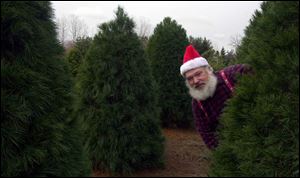
Fake trees put real crimp in live sales
12/2/2000
Wilford Salsberry, peering out from his Christmas tree farm near Delta, says older women are most resistant to live trees.
Christmas tree farmers have benefited from rising tree prices in recent years, but hopes of quickly closing in on the artificial tree market appear axed.
Nationally, the average price for live Christmas trees is predicted at $34 to $35 this year, up from $25 five years ago, according to the National Christmas Tree Association. Locally, trees are available for $5 to $100, and some farms and tree lots say their prices are the same as last year's.
The rising trend is good for tree farmers whose profits were much lower in the early 1990s, when there was a glut of Christmas trees. The tree association estimated the national average price in 1993 as $23.
The artificial tree market, however, is harder for them to chop down than they expected.
The tree association predicts farmers will sell 36 million live Christmas trees this year. But its Wirthlin Worldwide survey two weeks ago found that 46 million U.S. households plan to use an artificial tree, and 22 million households won't have a tree.
That's about 23 per cent more households with artificial trees this year than two years ago.
“The biggest thing I hear is `I'm too busy' and `I'm not going to be home,'” said Steve Drake, a Tiffin native who is chief executive of the tree association in St. Louis.
Single people, couples who don't have children, and retired people tend to be the toughest sells for live Christmas trees.
Wilford Salsberry, owner of Salsberry Tree Farm near the Fulton-Lucas county line, has found older women the least likely to want a live tree.
“Because of the cleanup,” he said. “The needles. They're tired of putting trees up and the mess of the needles.”
About 90 per cent of tree buyers at his farm come with children.
In Defiance County, Bill Plassman says 75 per cent of the customers of his Buckskin Tree Farm near Hicksville come with preschool or elementary school children.
At Mahnke Orchards in Napoleon, which expects to sell about 600 trees from North Carolina this year, about half of the tree buyers come with small children. Many of those families spend a long time, allowing a child to inspect every tree in the lot before picking one out and taking lots of pictures along the way, owner Dick Mahnke said.
To gain market share in wider groups, the tree association urges members to consider delivery and pickup after Christmas. It also recommends displaying a larger selection of small trees.
The top reason the association has heard in focus groups that artificial tree users say would lead them to buy a live tree is “If my children asked for it.”
Although raising Christmas trees is more profitable than most crops in the area, tree farming and sales tends to be a retirement or side business or a drawing card for other sales.
Mr. Salsberry, 56, who raises 700 acres of grain, retired this fall from driving a school bus. He expects to sell several hundred trees priced at $5 to $22 that he grows on land that is too poor for top corn crops.
The Mahnkes, who have sold trees for about 12 years, priced their selection at $20 to $56 this year, hoping their combination of price and quality will draw customers who will also pick up fruit that the family raises in Henry County.